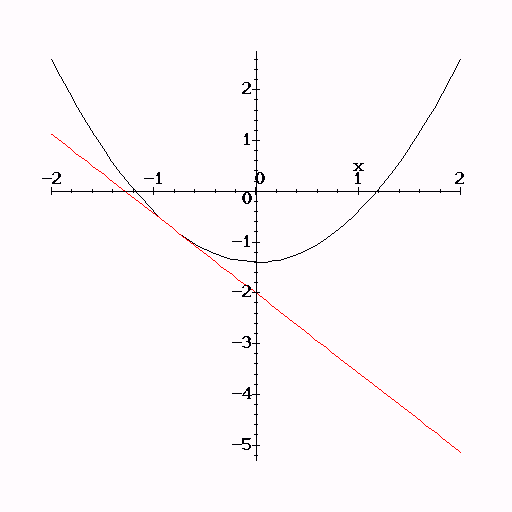Next: Bifurcation
Up: Table of Contents
Prev: Iteration
MODULE: Dynamical Systems.
Part 4: Linear and Nonlinear Functions
Linear functions are in general easier to study than nonlinear
ones. However, there is a relationship between nonlinear and linear
functions. Namely, iteration of a nonlinear function near a fixed
point is similar to iteration of a linear function with same
slope. The following section explains this statement and shows how it
can be used to predict whether a fixed point is attracting, repelling,
or neutral.

A function in the quadratic family, along with a line of the same
slope through the fixed point.
Study the long term behavior of linear maps. Namely, what is the
dynamics of g(x)=ax, a linear map with slope a? How does
the stability of the fixed point 0 change as parameter a
changes? Make sure to think about the case of a negative?
As mentioned before, near a fixed point iteration of a nonlinear map
is similar to the iteration of a specific linear map. Using this, you
can find a relationship between the slope of the graph at the fixed
point and whether the fixed point is attracting, repelling, or
neutral. First do so for the quadratic family:
- For a map in the quadratic family, what is the slope of its
graph at the fixed point?
- Iteration of a linear map with this slope is similar to
iteration of the quadratic function near the fixed point. For what
values of c should fixed points for the quadratic family be
attracting? Repelling? Neutral? Test your values using the Chaos Lab
#2.
- State the relationship between slope of the graph at the
fixed point and whether the fixed point is attracting, repelling, or
neutral.
- Recall that in order to find period two points, you graphed the
second iterate of the map. Can you find a relationship between the
slope of the graph of the second iterate of the function and whether the
period two points are attracting, repelling, or neutral?
- Describe geometrically how your relationship might generalize
to period n points.
Note: The procedure you found only works for periodic points with
small periods. Although it is nice to have the condition above for
whether a period n point is attracting, it becomes computationally
difficult to accurately graph the nth iterate of a map as n becomes
large.
Next: Bifurcation
Up: Table of Contents
Prev: Iteration
![[HOME]](/pix/home.gif) The Geometry Center Home Page
The Geometry Center Home Page
Author: Evelyn Sander
Comments to:
webmaster@www.geom.uiuc.edu
Created: Jun 09 1996 ---
Last modified: Jul 31 1996


![[HOME]](/pix/home.gif) The Geometry Center Home Page
The Geometry Center Home Page